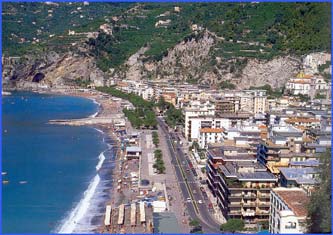|
 Maiori
is situated at the outlet of the Reginna Maior torrent, from which it derives
its name. Unfortunately the torrent is also a part of the town's history
for other reasons: it has often ruined the country with disastrous floods, as in
1910 and above all in 1954. Maiori
is situated at the outlet of the Reginna Maior torrent, from which it derives
its name. Unfortunately the torrent is also a part of the town's history
for other reasons: it has often ruined the country with disastrous floods, as in
1910 and above all in 1954.
This
latter catastrophe destroyed almost all the inhabited centre and it is ,for this
reason that Maiori, the only one among Amalfi coast's towns, presents itself to
visitors' eyes with numerous modern buildings.
From
the historical point of view Maiori was a faithful ally of the Amalfi Republic
for many years and for this reason it was fiercely attacked and sacked in many
occasione. The last time was in 1268 by the fleets of Pisa, a very fìerce
enemy of Amalfi.
So
a slow decline began and it worsened due to a plague in 1656 that reduced the
population to a few hundred inhabitants.
 However,
with the passing of time, thanks to the fertility of the area that in this part
of the Coast is less rough and rocky than elsewhere, the town recovered a
certain welfare so that today it is one of better-equipped tourist and bathing
centres. Nevertheless the town has preserved precious architectonic jewels
of great tourist interest that without doubt deserve a visit. However,
with the passing of time, thanks to the fertility of the area that in this part
of the Coast is less rough and rocky than elsewhere, the town recovered a
certain welfare so that today it is one of better-equipped tourist and bathing
centres. Nevertheless the town has preserved precious architectonic jewels
of great tourist interest that without doubt deserve a visit.
Besides
tbc Abbey of Santa Maria de' Olearia, the only Benedectine monument of the Coast
that has remained practically intact up to our times, wc must remember tbc
Castle, the Tower called "delle Formicole" and the church of S. Maria
al mare.
The
Mezzacapo Castle also called Miramare or S. Nicola, was built in tbc 15th
century on tbc rocky buttress of Ponticchio hill. Its gardens, of a
subsequent period, hide caves and rocky gorges with subterranean rivers,
cleverly integrated with lanes surrounded by rose-beds.
Today
the Tower of Formicole, built in 1590, is used as a restaurant and discobar by
whose name (Torre Normanna) it is generally known.
 In
tbc neighbourhood a source of sulphureous and drinkable water is also accessible
from tbc sea. The Church of S. Maria a Mare, with a splendid majolica
dome, was restored many times respecting the original nucleus dated at the 11 th
century. In
tbc neighbourhood a source of sulphureous and drinkable water is also accessible
from tbc sea. The Church of S. Maria a Mare, with a splendid majolica
dome, was restored many times respecting the original nucleus dated at the 11 th
century.
The
Baroque front is of remarkable interest with three portals of a subsequent
period (tbc 18th century). Inside there are rich artistic treasures among
which wc point out the lacunar cciling , built by Alessandro Fulco in tbc 16th
cent,ury and the wooden statue named "La Madonna col Bambino" (Madonna
with Baby). In the sacristy numerous small objects of art are also
conserved. From the landscape point of view, Capo d'Orso, extraordinary
rocky promontory on the sea, is part of the Municipality of Maiori. It
deserves a walk both by sea and by land.
|
